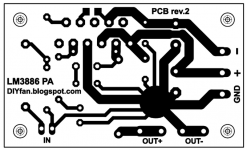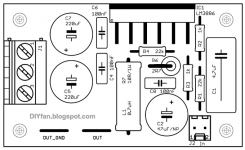Since, many amplifier chips are now switching types, I would like to ask if class AB amplifier chips are still in production? I am particularly interested to know, whether high power amplifier chips that use a split power supply are in still being manufactured.
By high power I mean a power from 50W RMS upwards.
Many modern amplifier chips are SMD type centipede like chips that are class D, that is, a switching power supply with an audio signal in its pulse modulator.
By high power I mean a power from 50W RMS upwards.
Many modern amplifier chips are SMD type centipede like chips that are class D, that is, a switching power supply with an audio signal in its pulse modulator.
As a rule any amplifier with the prefix of TDA is class AB and most are still in production.
TDA7293 - 120 V / 100 W DMOS audio amplifier with mute and standby - STMicroelectronics
as an example
TDA7293 - 120 V / 100 W DMOS audio amplifier with mute and standby - STMicroelectronics
as an example
Where is the line?
Class A - device conducts the full 360° of the sine wave
Class B - device conducts 180°.
Class C - device conducts less than 180°.
So if the bias is set so that the device conducts 190°, is it class B or AB? What if it conducts 181° - Class A or AB? 180.1°?
What if it conducts 179°, is it class C?
Class A - device conducts the full 360° of the sine wave
Class B - device conducts 180°.
Class C - device conducts less than 180°.
So if the bias is set so that the device conducts 190°, is it class B or AB? What if it conducts 181° - Class A or AB? 180.1°?
What if it conducts 179°, is it class C?
i mean the optimum bias current...chipamp harmonics at the output - indicate that this is not optimum...
Where is the line?
Class A - device conducts the full 360° of the sine wave
Class B - device conducts 180°.
Class C - device conducts less than 180°.
So if the bias is set so that the device conducts 190°, is it class B or AB? What if it conducts 181° - Class A or AB? 180.1°?
What if it conducts 179°, is it class C?
Operation is either class A or B. A class AB amplifier operates in class B when one output device crosses over to the other, the level of bias determines at what signal level this happens.
The LM3886 is one of the most highly regarded and can be configured (parallel operation) to deliver some serious power.
Have a look at the Neurochrome site of diyAudio member tomchr, the link is in his signature line to see just how good the LM3886 can be.
Have a look at the Neurochrome site of diyAudio member tomchr, the link is in his signature line to see just how good the LM3886 can be.
Amplifier class is not determined by instantaneous condition, it is defined as operation over a full sine wave.Operation is either class A or B. A class AB amplifier operates in class B when one output device crosses over to the other, the level of bias determines at what signal level this happens.
A class AB amplifier operating with a small signal may stay within class A boundries, but a class AB amplifier will never operate fully as class B.
I have always used low bias currents in my designs.
It doesn't take much to get rid of crossover distortion.
I can't speak for other types of distortion as I cant measure it without a spectrum analyser.
Peavey are big fans of low bias too.
Why waste valuable power as heat if you dont need to ?
It doesn't take much to get rid of crossover distortion.
I can't speak for other types of distortion as I cant measure it without a spectrum analyser.
Peavey are big fans of low bias too.
Why waste valuable power as heat if you dont need to ?
Optimum performance is as much implementation as design. Most chipamplifiers avoid high bias currents by using low current topologies such as a quasi-complementary design - but don't go looking to fit bias controls just to have something to fiddle with.
The LM3886 family of chipamps is based on this type of output stage and as Mooly refers, they really can deliver exemplary performance, whether you believe that other discrete topologies are superior or not. Be amazed - check the facts LM3886 Done Right
LM3886 Done Right
The LM3886 family of chipamps is based on this type of output stage and as Mooly refers, they really can deliver exemplary performance, whether you believe that other discrete topologies are superior or not. Be amazed - check the facts
 LM3886 Done Right
LM3886 Done RightChip amplifiers are attractive as they hide much of amplifier complexity. I will give LM3886 a try since it is claimed it boasts of a THD of 0.03% and a split power supply. The amplifier's closed loop is externally controlled. Searching online for a ready designed PCB layout I found the attached files. Comments are most welcome. I will make the actual PCBs at home using the Toner Transfer Method but instead of using heat and pressure, I will use acetone and water.
Note: These PCB layouts are NOT mine. I downloaded them from:
50W Power Amplifier with LM3886 - Electronics-Lab
Note: These PCB layouts are NOT mine. I downloaded them from:
50W Power Amplifier with LM3886 - Electronics-Lab
Attachments
Make sure the feedback resistor path is as short as possible.
If its long you can get oscillation.
If its long you can get oscillation.
I really like the TDA7293 ones. I built this design the other evening and stayed up way too late listening to song after song on it
Project 127
postage on the pcbs can take a long long time but if you are making your own that isn't an issue.
Project 127
postage on the pcbs can take a long long time but if you are making your own that isn't an issue.
- Home
- Amplifiers
- Solid State
- Are class AB chip amplifiers still in production?

